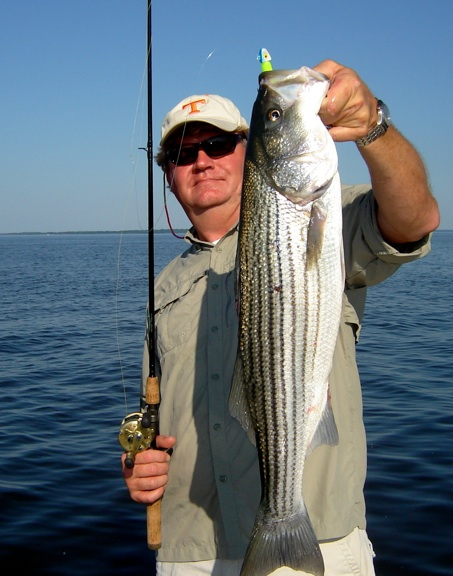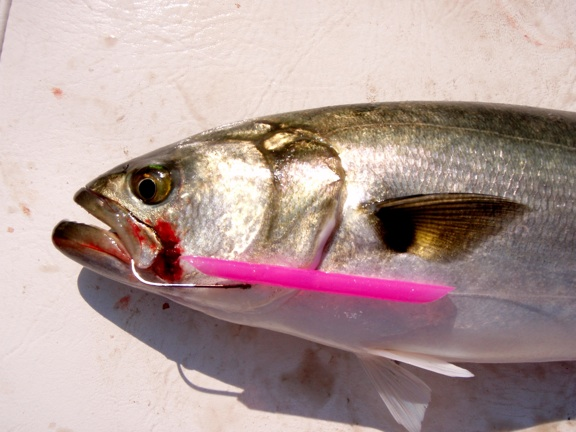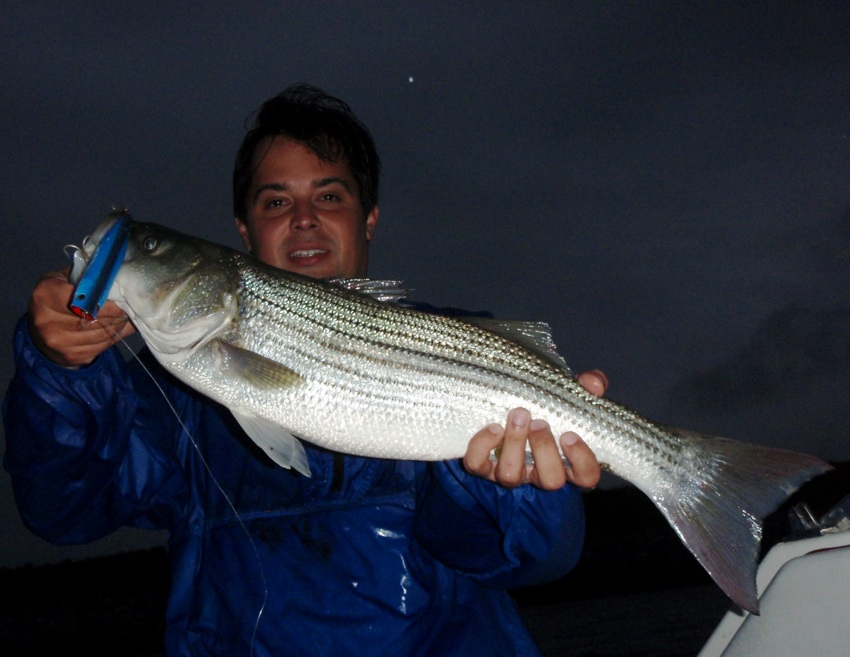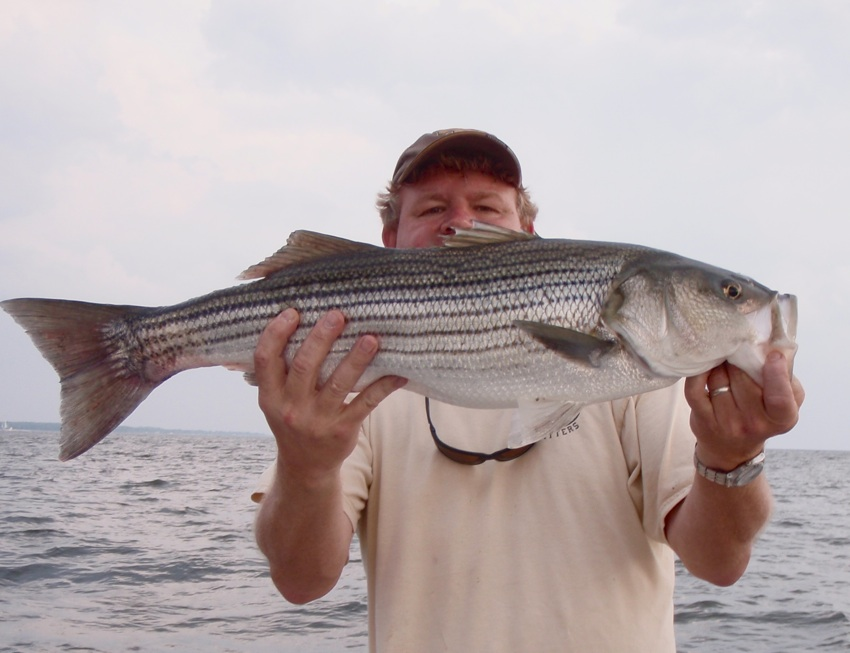 I mentioned in an earlier “How-To” article that I would write about interesting jigging situations when I encountered them. We’re in the middle of some amazing summer fishing. I’ve been chasing breakers over hard bottoms on both sides of the Bay. This is a typical Chesapeake hot-weather pattern which will usually last and even intensify until fall.
I mentioned in an earlier “How-To” article that I would write about interesting jigging situations when I encountered them. We’re in the middle of some amazing summer fishing. I’ve been chasing breakers over hard bottoms on both sides of the Bay. This is a typical Chesapeake hot-weather pattern which will usually last and even intensify until fall.
The challenge presented by blitzing fish is not in finding the right lure. Almost any lure will catch when fish are in a wild surface-feeding frenzy. I’ve caught rock and blues with a bare hook using only a cut-off piece of a pink soda-straw for bait. I know other fishermen who routinely use a church-key can-opener with attached hooks as a fishing lure for casting into breakers. When working a blitz, the difficult part comes in getting larger fish, especially keeper-size stripers out of the schools.
Generally speaking, smaller fish are more likely to be closer to the surface during a feeding blitz. Fish of  similar size usually school together, but bigger fish will often run underneath the juveniles scavenging for the scraps that filter down. If you’ve ever looked at a school of striped bass in a Bass Pro Shops-style aquarium, you’ve surely noticed that rockfish stack up like a pyramid with bigger ones on the bottom and smaller ones on top. So bigger fish can often be caught from beneath blitzing schools when the fish are feeding over deeper water.
similar size usually school together, but bigger fish will often run underneath the juveniles scavenging for the scraps that filter down. If you’ve ever looked at a school of striped bass in a Bass Pro Shops-style aquarium, you’ve surely noticed that rockfish stack up like a pyramid with bigger ones on the bottom and smaller ones on top. So bigger fish can often be caught from beneath blitzing schools when the fish are feeding over deeper water.
But the situation we’ve encountered in the past few weeks has been somewhat different. The fish are often blitzing in water that is sometimes only 7 or 8 feet deep. There’s hardly any room at all to jig beneath them. When you try, each cast turns up only another fiesty 16 inch rockfish or a lightweight snapper blue.
If your goal is to catch bigger fish, here’s something you can try. To be clear, by “bigger,” I mean “summer bigger,” which includes 3 or 4 year-old fish up to 28 inches or so. Although it happens sometimes, it’s rare to find healthy rockfish over 30 inches during mid-summer months in the Chesapeake Bay. Basically, there are two steps.
 Step One – upsize your lures. With all the bluefish around, you’re probably using metal. Look for thin lures that are at least 6 or 7 inches long. A big spoon fits the bill because they usually aren’t as heavy as lead jigs. Better yet, try a large top-water plug. My favorites are at least 5 inches long or bigger. Both poppers and spooks will work. The smaller fish will swirl at it, but the lure is usually too big for them to get in their mouth. On the other hand, that plug is just the ticket for a big hungry rockfish. The little ones will swirl and smack, but they usually won’t get hooked. Look for the hawgs to come busting through the fray after the heartier meal you’re offering.
Step One – upsize your lures. With all the bluefish around, you’re probably using metal. Look for thin lures that are at least 6 or 7 inches long. A big spoon fits the bill because they usually aren’t as heavy as lead jigs. Better yet, try a large top-water plug. My favorites are at least 5 inches long or bigger. Both poppers and spooks will work. The smaller fish will swirl at it, but the lure is usually too big for them to get in their mouth. On the other hand, that plug is just the ticket for a big hungry rockfish. The little ones will swirl and smack, but they usually won’t get hooked. Look for the hawgs to come busting through the fray after the heartier meal you’re offering.
Step Two – drift away. It may seem counter intuitive to a fisherman who has spent a couple of hours  running around trying to locate the breaking schools, but the best thing to do is leave. By leave, I mean you should allow the current to drift your boat away from the blitz. Once you get out of casting range of the breakers, start watching the fish finder. Since the bigger fish can’t get beneath the breaking juveniles in the shallow water, they’re likely to move off downstream in their efforts to clean up those tasty table scraps. Just maintain your drift.
running around trying to locate the breaking schools, but the best thing to do is leave. By leave, I mean you should allow the current to drift your boat away from the blitz. Once you get out of casting range of the breakers, start watching the fish finder. Since the bigger fish can’t get beneath the breaking juveniles in the shallow water, they’re likely to move off downstream in their efforts to clean up those tasty table scraps. Just maintain your drift.
Even if you’ve stopped marking fish, stay on that drift a little while. It’s not unusual for another school to appear every dozen yards or so. The best lures for this situation are soft plastics, especially tooth-proof fluke-types like Strike King’s Zulu line. These new generation plastics will last through several bluefish attacks. The only drawback is that they almost always have to be super-glued to the jig head or they won’t stay attached. Use a heavier jig head so that you’re absolutely certain your lure is bouncing on the bottom after each snap of the rod.
Remember that fish are more fragile in hot weather. As always, it’s a good idea to cut the trebles off your top-water baits and remove the barbs from your single hooks when throwing to juvenile breaking fish. Blitzing rockfish and blues can be great warm-weather fun, but don’t give up on bigger game, there’s some decent fish out there just waiting for the fishermen with the right technique to come along and catch them! Small fish in the breaks doesn’t have to be the highlight of your summer dog days.





To whom this may concern;
This is a test on the timeliness of replies.
I just read your latest article. One of my favorites this summer. I especially enjoyed that extremely handsome man pictured with the rather heavy and beautiful Striper. And I’m not talking about that fish.
I would like to apply as your Chief Scientist. When you start building your staff, I would like to be considered for this position.
I may have mentioned that tin jigs have the properties of sinking slower than lead jigs giving them more time in the strike zone on breaking fish.
Tomato Kaiser sends…
Thanks for the compliment about the handsome man with the heavy beautiful striper. You must be talking about the first or last picture in the article. I also included some pictures of other fishermen to balance the equation. Oh, and by the way… timely this! 🙂
Mr. Shawn;
Drawing on my fine command of the English language, I said nothing.
p.s. Could you please obtain permission to share your Bluefish recipe with the readers.
Thanks.
Thirty inch fish in July,you have to love that.;)